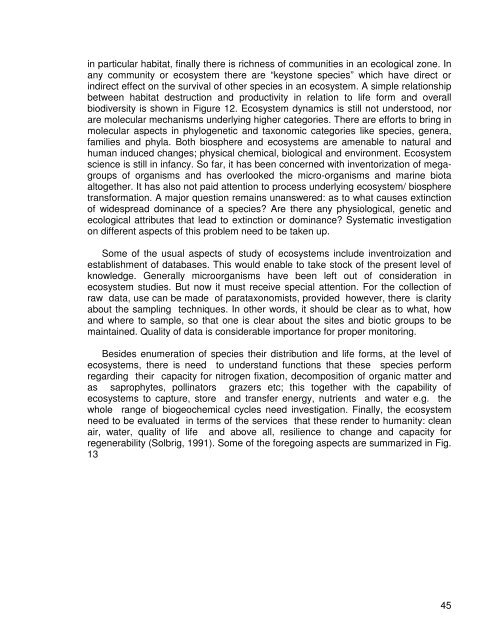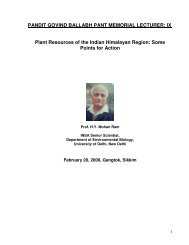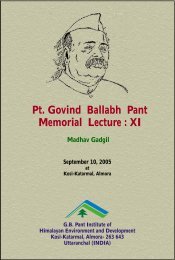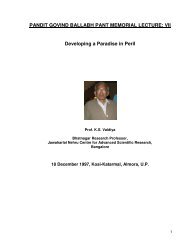Pandit Govind Ballabh Pant Memorial Lecture: II
Pandit Govind Ballabh Pant Memorial Lecture: II
Pandit Govind Ballabh Pant Memorial Lecture: II
You also want an ePaper? Increase the reach of your titles
YUMPU automatically turns print PDFs into web optimized ePapers that Google loves.
in particular habitat, finally there is richness of communities in an ecological zone. In<br />
any community or ecosystem there are “keystone species” which have direct or<br />
indirect effect on the survival of other species in an ecosystem. A simple relationship<br />
between habitat destruction and productivity in relation to life form and overall<br />
biodiversity is shown in Figure 12. Ecosystem dynamics is still not understood, nor<br />
are molecular mechanisms underlying higher categories. There are efforts to bring in<br />
molecular aspects in phylogenetic and taxonomic categories like species, genera,<br />
families and phyla. Both biosphere and ecosystems are amenable to natural and<br />
human induced changes; physical chemical, biological and environment. Ecosystem<br />
science is still in infancy. So far, it has been concerned with inventorization of megagroups<br />
of organisms and has overlooked the micro-organisms and marine biota<br />
altogether. It has also not paid attention to process underlying ecosystem/ biosphere<br />
transformation. A major question remains unanswered: as to what causes extinction<br />
of widespread dominance of a species? Are there any physiological, genetic and<br />
ecological attributes that lead to extinction or dominance? Systematic investigation<br />
on different aspects of this problem need to be taken up.<br />
Some of the usual aspects of study of ecosystems include inventroization and<br />
establishment of databases. This would enable to take stock of the present level of<br />
knowledge. Generally microorganisms have been left out of consideration in<br />
ecosystem studies. But now it must receive special attention. For the collection of<br />
raw data, use can be made of parataxonomists, provided however, there is clarity<br />
about the sampling techniques. In other words, it should be clear as to what, how<br />
and where to sample, so that one is clear about the sites and biotic groups to be<br />
maintained. Quality of data is considerable importance for proper monitoring.<br />
Besides enumeration of species their distribution and life forms, at the level of<br />
ecosystems, there is need to understand functions that these species perform<br />
regarding their capacity for nitrogen fixation, decomposition of organic matter and<br />
as saprophytes, pollinators grazers etc; this together with the capability of<br />
ecosystems to capture, store and transfer energy, nutrients and water e.g. the<br />
whole range of biogeochemical cycles need investigation. Finally, the ecosystem<br />
need to be evaluated in terms of the services that these render to humanity: clean<br />
air, water, quality of life and above all, resilience to change and capacity for<br />
regenerability (Solbrig, 1991). Some of the foregoing aspects are summarized in Fig.<br />
13<br />
45











